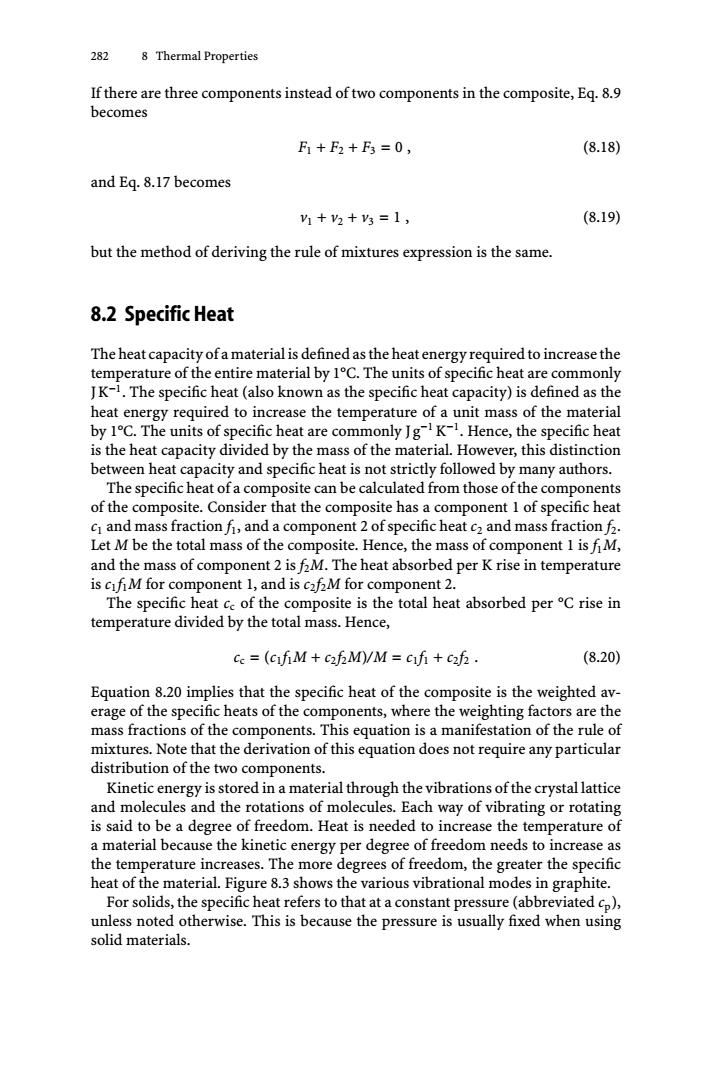正在加载图片...

282 8 Thermal Properties If there are three components instead of two components in the composite,Eq.8.9 becomes F1+F2+F3=0, (8.18) and Eq.8.17 becomes V1+V2+3=1, (8.19) but the method of deriving the rule of mixtures expression is the same. 8.2 Specific Heat The heat capacity of a material is defined as the heat energy required to increase the temperature of the entire material by 1C.The units of specific heat are commonly JK-1.The specific heat(also known as the specific heat capacity)is defined as the heat energy required to increase the temperature of a unit mass of the material by 1C.The units of specific heat are commonly JgK-1.Hence,the specific heat is the heat capacity divided by the mass of the material.However,this distinction between heat capacity and specific heat is not strictly followed by many authors. The specific heat of a composite can be calculated from those of the components of the composite.Consider that the composite has a component 1 of specific heat c and mass fraction fi,and a component 2 of specific heat c2 and mass fraction f2. Let M be the total mass of the composite.Hence,the mass of component l is fiM, and the mass of component 2 is f2M.The heat absorbed per K rise in temperature is cifiM for component 1,and is c2f2M for component 2. The specific heat ce of the composite is the total heat absorbed per C rise in temperature divided by the total mass.Hence, cc (cifiM+c2fM)/M=cif +c2f2. (8.20) Equation 8.20 implies that the specific heat of the composite is the weighted av- erage of the specific heats of the components,where the weighting factors are the mass fractions of the components.This equation is a manifestation of the rule of mixtures.Note that the derivation of this equation does not require any particular distribution of the two components. Kinetic energy is stored in a material through the vibrations of the crystal lattice and molecules and the rotations of molecules.Each way of vibrating or rotating is said to be a degree of freedom.Heat is needed to increase the temperature of a material because the kinetic energy per degree of freedom needs to increase as the temperature increases.The more degrees of freedom,the greater the specific heat of the material.Figure 8.3 shows the various vibrational modes in graphite. For solids,the specific heat refers to that at a constant pressure(abbreviated cp), unless noted otherwise.This is because the pressure is usually fixed when using solid materials.282 8 Thermal Properties If there are three components instead of two components in the composite, Eq. 8.9 becomes F1 + F2 + F3 = 0 , (8.18) and Eq. 8.17 becomes v1 + v2 + v3 = 1 , (8.19) but the method of deriving the rule of mixtures expression is the same. 8.2 Specific Heat The heat capacity of a material is defined as the heat energy required to increase the temperature of the entire material by 1°C. The units of specific heat are commonly JK−1. The specific heat (also known as the specific heat capacity) is defined as the heat energy required to increase the temperature of a unit mass of the material by 1°C. The units of specific heat are commonly Jg−1 K−1. Hence, the specific heat is the heat capacity divided by the mass of the material. However, this distinction between heat capacity and specific heat is not strictly followed by many authors. The specific heat of a composite can be calculated from those of the components of the composite. Consider that the composite has a component 1 of specific heat c1 and mass fraction f1, and a component 2 of specific heat c2 and mass fraction f2. Let M be the total mass of the composite. Hence, the mass of component 1 is f1M, and the mass of component 2 is f2M. The heat absorbed per K rise in temperature is c1f1M for component 1, and is c2f2M for component 2. The specific heat cc of the composite is the total heat absorbed per °C rise in temperature divided by the total mass. Hence, cc = (c1f1M + c2f2M)/M = c1f1 + c2f2 . (8.20) Equation 8.20 implies that the specific heat of the composite is the weighted average of the specific heats of the components, where the weighting factors are the mass fractions of the components. This equation is a manifestation of the rule of mixtures. Note that the derivation of this equation does not require any particular distribution of the two components. Kinetic energy is stored in a material through the vibrations of the crystal lattice and molecules and the rotations of molecules. Each way of vibrating or rotating is said to be a degree of freedom. Heat is needed to increase the temperature of a material because the kinetic energy per degree of freedom needs to increase as the temperature increases. The more degrees of freedom, the greater the specific heat of the material. Figure 8.3 shows the various vibrational modes in graphite. For solids, the specific heat refers to that at a constant pressure (abbreviated cp), unless noted otherwise. This is because the pressure is usually fixed when using solid materials